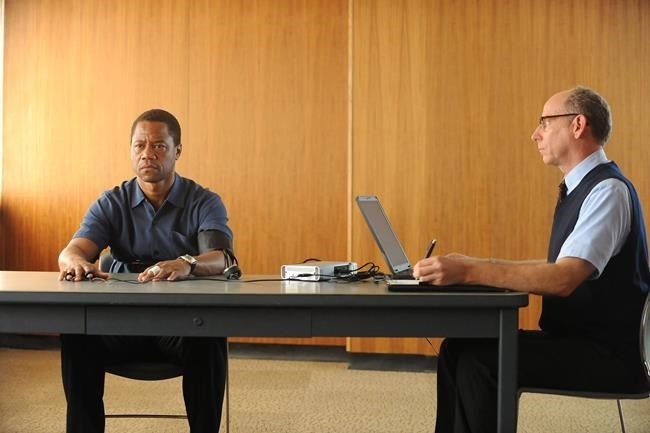
In this undated handout image from FX, Cuba Gooding Jr. portrays O.J. Simpson, left, in a scene from "The People v. O.J. Simpson: American Crime Story," a 10-part series. From "Making a Murderer" to two highly acclaimed series centred on O.J. Simpson, a recent spate of true crime stories on the small screen that have generated significant offscreen buzz about historic cases.
Image Credit: THE CANADIAN PRESS/AP-HO/FX, Ray Mickshaw, *MANDATORY CREDIT*
July 17, 2016 - 8:30 AM
TORONTO - A recent spate of long-form true-crime projects has captivated audiences, won critical acclaim and renewed interest in old cases.
But the genre presents a unique challenge for those involved in creating compelling stories involving real victims and often gruesome subject matter.
"These things inevitably will reopen wounds just simply by bringing the past back to the present," admits Dean Strang, one of the defence lawyers for Steven Avery featured in the Netflix hit "Making a Murderer," which picked up six Emmy nominations on Thursday.
The documentary series, along with two recent hit series on O.J. Simpson, have contributed to making the true-crime genre a modern pop culture phenomenon.
"The People v. O.J. Simpson: American Crime Story" received 22 Emmy nominations, just one shy of overall leader "Game of Thrones." The 10-part FX series offers a fictionalized retelling of the '90s murder trial in the deaths of Simpson's ex-wife Nicole Brown Simpson and her friend Ronald Goldman.
Also widely acclaimed — but not eligible for this year's Emmys — is the documentary series "O.J.: Made in America."
Director Ezra Edelman said he was sensitive to portraying his subjects in an honest way when creating the series and treating their stories respectfully.
"I think this story occupies this weird space where it's been talked about so much (over the years) so in that way is it possible to say anything wrong?" said Edelman during an interview at the HotDocs festival in Toronto.
"Having said this, I take my role and responsibility pretty seriously."
Strang said true-crime genre stories have an "an excruciatingly difficult balance to strike."
In the case of "Making a Murderer," the series explores Avery's first-degree intentional homicide trial in the 2005 death of photographer Teresa Halbach.
"I don't know that one ever could achieve consensus that the balance has been struck correctly, because there's enormous public good in an honest, unfiltered look at our criminal justice institutions," Strang said in a recent interview in support of his "A Conversation on Justice" speaking tour with Avery co-counsel Jerry Buting.
"On the other hand ... the burden of that public good falls on the families of victims who've already suffered a horrible loss, one that they couldn't have prepared for, didn't deserve and, in some ways, can never overcome."
Soraya Peerbaye recently won the English-language Trillium Book Award for poetry for "Tell: poems for a girlhood," based on the case of slain Vancouver Island teen Reena Virk. The Toronto writer admitted she wrestled with finding the right approach.
"There was really a desire to be accountable, to be respectable for Reena, not only as someone who died but as someone who lived," said Peerbaye, whose collection was also a finalist for the 2016 Griffin Poetry Prize.
"As artists, we're also trying with integrity to generate new ways of looking at our world ... to open up our sensibilities or our empathy, our senses of history."
David Schmid, editor of the true-crime collection "Violence in American Popular Culture," said the issue of striking the right tone has been a perennial one for the genre, dating back to true-crime accounts in the 19th century.
"On the one hand, they want to entertain their readers, and they want to make money and they want to get large audiences," said Schmid, a professor of English at the University of Buffalo.
"At the same time, they have to find some kind of justification to make the reader feel that they're not in fact being entertained by murder, that true crime does in fact have a useful social purpose."
Schmid said what distinguishes the current crop of true-crime narratives is how they're being used as a way to address and overturn examples of potential injustice, pointing to "Making A Murderer" and the popular podcast "Serial."
Avery is pursuing an appeal. Last month, Adnan Syed, the focal point of season 1 of "Serial," was granted a new trial 16 years after being convicted in the death of Hae Min Lee, his high school girlfriend.
"That's not something that we've previously seen in the genre," said Schmid.
"So, in that respect, it represents kind of a radical turn in terms of what people think true crime can do."
— With files from Canadian Press reporter David Friend and The Associated Press.
News from © The Canadian Press, 2016